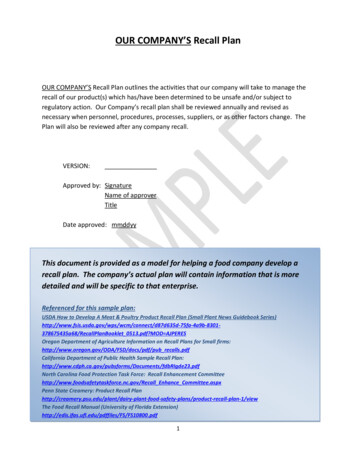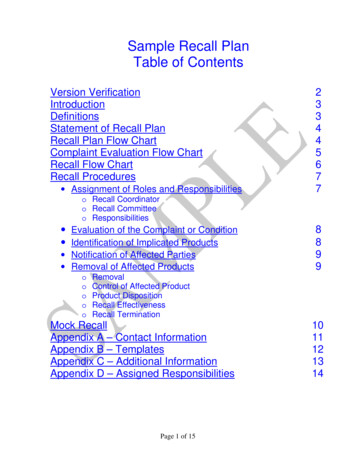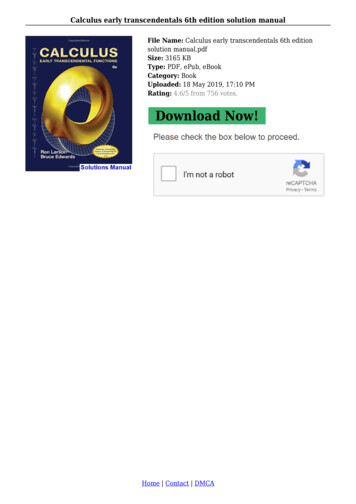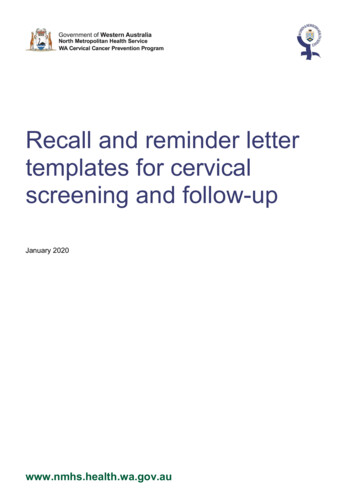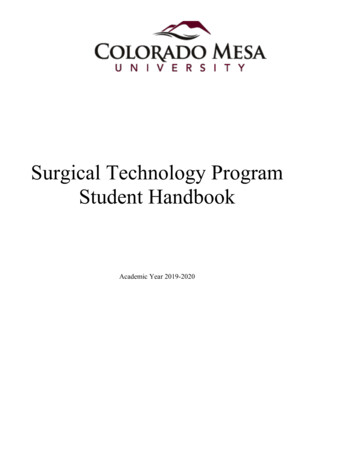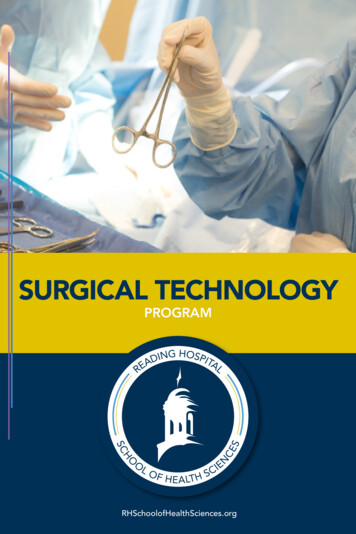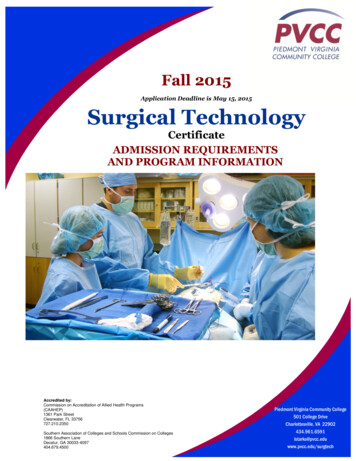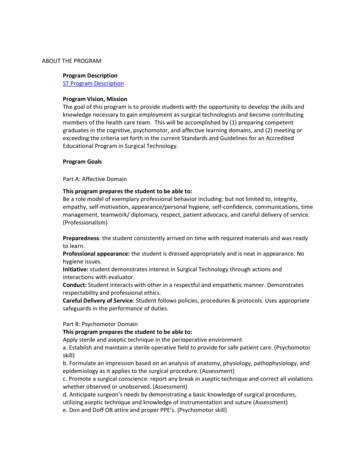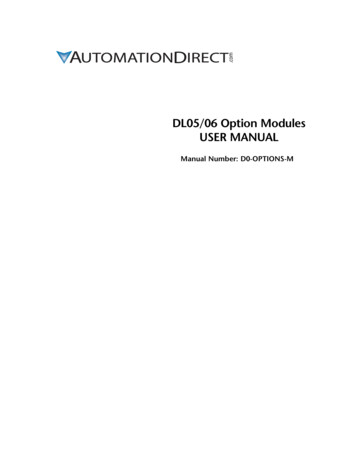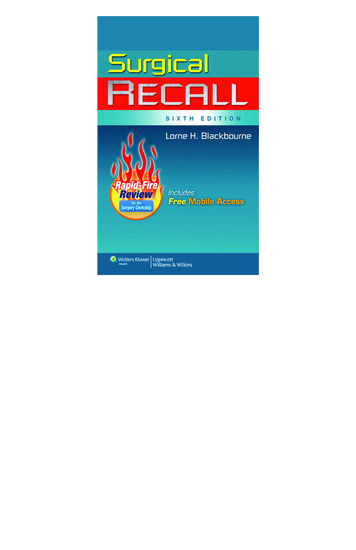
Transcription
LWBK758-FM pi-xii.qxd 3/15/11 5:05AM Page i AptaraSURGICAL RECALL6th Edition
LWBK758-FM pi-xii.qxd 3/15/11 5:05AM Page ii Aptara
LWBK758-FM pi-xii.qxd 3/15/11 5:05AM Page iii AptaraSURGICAL RECALL6th EditionRECALL SERIES EDITOR AND SENIOR EDITORLorne H. Blackbourne, M.D., F.A.C.S.Trauma, Burn, and Critical Care SurgeonSan Antonio,Texas“In the operating room we can save more lives, cure morecancer, restore more function, and relieve more sufferingthan anywhere else in the hospital.”—R. SCOTT JONES, M.D.
LWBK758-FM pi-xii.qxd 3/15/11 5:05AM Page iv AptaraAcquisitions Editor: Susan RhynerProduct Manager: Joyce MurphyMarketing Manager: Joy Fisher-WilliamsManufacturing Manager: Margie OrzechDesign Coordinator: Holly Reid McLaughlinCompositor: Aptara, Inc.Sixth EditionCopyright 2012, 2009, 2006, 2002, 1998, 1994 Lippincott Williams & Wilkins, a Wolters Kluwer business.351 West Camden StreetBaltimore, MD 21201Two Commerce Square, 2001 Market StreetPhiladelphia, PA 19103Printed in ChinaAll rights reserved. This book is protected by copyright. No part of this book may be reproduced or transmitted in any form or by any means, including as photocopies or scanned-in or other electronic copies, orutilized by any information storage and retrieval system without written permission from the copyrightowner, except for brief quotations embodied in critical articles and reviews. Materials appearing in this bookprepared by individuals as part of their official duties as U.S. government employees are not covered by theabove-mentioned copyright. To request permission, please contact Lippincott Williams & Wilkins at530 Walnut Street, Philadelphia, PA 19106, via email at permissions@lww.com, or via website at lww.com(products and services).987654321Library of Congress Cataloging-in-Publication DataSurgical recall / Recall series editor and senior editor, Lorne H.Blackbourne, M.D., F.A.C.S., Trauma, Burn, and Critical Care Surgeon,San Antonio, Texas. – 6th edition.p. ; cm. – (Recall series)Includes index.Summary: “Written by students, residents, and experts in the field,Surgical Recall faciliatates rapid review and memorization with aconcise question-and-answer format”–Provided by publisher.ISBN 978-1-60831-421-8 (alkaline paper)1. Surgery–Examinations, questions, etc. I. Blackbourne, Lorne H.,editor. II. Series: Recall series.[DNLM: 1. Surgical Procedures, Operative–Examination Questions. WO18.2]RD37.2.S9748 2012617.0076–dc222010044314DISCLAIMERCare has been taken to confirm the accuracy of the information present and to describe generallyaccepted practices. However, the authors, editors, and publisher are not responsible for errors or omissionsor for any consequences from application of the information in this book and make no warranty, expressedor implied, with respect to the currency, completeness, or accuracy of the contents of the publication. Application of this information in a particular situation remains the professional responsibility of the practitioner;the clinical treatments described and recommended may not be considered absolute and universal recommendations.The authors, editors, and publisher have exerted every effort to ensure that drug selection and dosageset forth in this text are in accordance with the current recommendations and practice at the time of publication. However, in view of ongoing research, changes in government regulations, and the constant flow ofinformation relating to drug therapy and drug reactions, the reader is urged to check the package insert foreach drug for any change in indications and dosage and for added warnings and precautions. This is particularly important when the recommended agent is a new or infrequently employed drug.Some drugs and medical devices presented in this publication have Food and Drug Administration (FDA)clearance for limited use in restricted research settings. It is the responsibility of the health care provider toascertain the FDA status of each drug or device planned for use in their clinical practice.To purchase additional copies of this book, call our customer service department at (800) 638-3030 or faxorders to (301) 223-2320. International customers should call (301) 223-2300.Visit Lippincott Williams & Wilkins on the Internet: http://www.lww.com. Lippincott Williams & Wilkinscustomer service representatives are available from 8:30 am to 6:00 pm, EST.
LWBK758-FM pi-xii.qxd 3/15/11 5:05AM Page v AptaraDedicationThis book is dedicated to the memory of Leslie E. Rudolf,Professor of Surgery and Vice-Chairman of the Department of Surgery at the University of Virginia. Dr. Rudolfwas born on November 12, 1927, in New Rochelle, NewYork. He served in the U.S. Army Counter-IntelligenceCorps in Europe after World War II.He graduated from Union College in 1951 andattended Cornell Medical College, where he graduatedin 1955. He then entered his surgical residency atPeter Brigham Hospital in Boston, Massachusetts,and completed his residency there, serving as Chief Resident Surgeonin 1961.Dr. Rudolf came to Charlottesville, Virginia as an Assistant Professor ofSurgery in 1963. He rapidly rose through the ranks, becoming Professor ofSurgery and Vice-Chairman of the Department in 1974 and a Markle Scholarin Academic Medicine from 1966 until 1971. His research interests includedorgan and tissue transplantation and preservation. Dr. Rudolf was instrumental in initiating the Kidney Transplant Program at the University of VirginiaHealth Sciences Center. His active involvement in service to the Charlottesville community is particularly exemplified by his early work with theCharlottesville/Albemarle Rescue Squad, and he received the Governor’s Citationfor the Commonwealth of Virginia Emergency Medical Services in 1980.His colleagues at the University of Virginia Health Sciences Center, including faculty and residents, recognized his keen interests in teaching medicalstudents, evaluating and teaching residents, and helping the young surgicalfaculty. He took a serious interest in medical student education, and he wouldhave strongly approved of this teaching manual, affectionately known as the“Rudolf” guide, as an extension of ward rounds and textbook reading.In addition to his distinguished academic accomplishments, Dr. Rudolf wasa talented person with many diverse scholarly pursuits and hobbies. His adviceand counsel on topics ranging from Chinese cooking to orchid raising weresought by a wide spectrum of friends and admirers.This book is a logical extension of Dr. Rudolf’s interests in teaching. No onebook, operation, or set of rounds can begin to answer all questions of surgicaldisease processes; however, in a constellation of learning endeavors, this effortwould certainly have pleased him.John B. Hanks, M.D.Professor of SurgeryUniversity of VirginiaCharlottesville, Virginiav
LWBK758-FM pi-xii.qxd 3/15/11 5:05AM Page vi AptaraEditors and ContributorsADVISOR:Curtis G. Tribble, M.D.Professor of SurgeryUniversity of MississippiJackson, MississippiPAST EDITORS ANDCONTRIBUTORS:Bruce Crookes, M.D.C. Suzanne Cutter, M.D.Alfa O. Diallo, M.D.Rupen G. Modi, M.B.A.Paymann Moin, B.S.Todd M. Morgan, M.D.Andrew Newman, B.S.Louis Pizano, M.D.Dimitris G. Placantonakis,M.D. PH.D.Justin Yovino, M.D.Matthew Edwards, M.D.Esteban Ambrad-Chalela,M.D.Ara J. Fienstein, M.D.David Chessin, M.D.E. William Johnson, M.D.Owen Johnson, B.S.Peter Lopez, M.D.Peter T. Kennealy, M.D.Martin I. Newman, M.D.Geoffery Lam, M.D.Carl Schulman, M.D.Garrett Nash, M.D.David Shatz, M.D.Inderpal Sarkaria, M.D.Nicholas R. Alverez, B.S.Alysandra Schwarz, M.D.Jos Amortequi, M.D.Ali Vafa, M.D.Joshua I. Bleier, M.D.Nabil Wasif, M.D.Andrew Cameron, M.D.Diane Diesen, M.D.Gladys L. Giron, M.D.Lawerence V. Gulotta, M.D.Fahim Habib, M.D.Jennifer Hall, M.D.David King, M.D.Joseph Michaels V, M.D.viINTERNATIONAL EDITORS:Mohammad Azfar, M.B.B.S.,F.R.C.S.General SurgeonAbu Dhabi, United Arab EmiratesGwinyai Masukume, M.B.CH.B.University of ZimbabweCollege of Health SciencesHarare, Zimbabwe
LWBK758-FM pi-xii.qxd 3/15/11 5:05AM Page vii AptaraForewordSurgical Recall represents the culmination of several years’ effort by LorneBlackbourne and his friends, who began the project when they were third-yearmedical students. Lorne, who completed his residency in General Surgery atthe University of Virginia, has involved other surgical residents and medicalstudents to provide annual updates and revisions.This reflects the interest, enthusiasm, and true dedication to learning andteaching that permeates the medical school classes and surgical residencies inour institution. It is an honor, privilege, and a continuing stimulus to work inthe midst of this group of dedicated young people. I congratulate all the students and residents involved in this project and also acknowledge the leadership of the surgical faculty. The professor’s ultimate satisfaction occurs whenall the learners assume ownership of learning and teaching.This book encompasses the essential information in general surgery and surgical specialties usually imparted to students in our surgical clerkship andreviewed and developed further in electives. Developed from the learner’sstandpoint, the text includes fundamental information such as a description ofthe diseases, signs, symptoms, essentials of pathophysiology, treatments, andpossible outcomes. The unique format of this study guide uses the Socraticmethod by employing a list of questions or problems posed along the left side ofthe page with answers or responses on the right. In addition, the guide includesnumerous practical tips for students and junior residents to facilitate comprehensive and effective management of patients. This material is essential forstudents in the core course of surgery and for those taking senior electives.R. Scott Jones, M.D.University of VirginiaCharlottesville, Virginiavii
LWBK758-FM pi-xii.qxd 3/15/11 5:05AM Page viii AptaraPrefaceSurgical Recall began as a source of surgical facts during my Surgery Clerkshipwhen I was a third-year medical student at the University of Virginia. My goalhas been to provide concise information that every third-year surgical studentshould know in a “rapid fire,” two-column format.The format of Surgical Recall is conducive to the recall of basic surgicalfacts because it relies on repetition and positive feedback. As one repeats thequestion-and-answer format, one gains success.We have dedicated our work to the living memory of Professor LeslieRudolf. It is our hope that those who knew Dr. Rudolf will remember him andthose who did not will ask.Lorne H. Blackbourne, M.D., F.A.C.STrauma, Burn, and Critical Care SurgeonSan Antonio, TexasP.S. We would like to hear from you if you have any corrections, acronyms, andclassic ward or operating room questions (all contributors will be credited).You can reach me via e-mail in care of Lippincott Williams & Wilkins atbook comments@lww.com.viii
LWBK758-FM pi-xii.qxd 3/17/11 7:22 PM Page ix AptaraContentsDedication . . . . . . . . . . . . . . . . . . . . . . . . . . . . . . . . . . . . . . . . . . . . . .vEditors and Contributors . . . . . . . . . . . . . . . . . . . . . . . . . . . . . . . . . . .viForeword . . . . . . . . . . . . . . . . . . . . . . . . . . . . . . . . . . . . . . . . . . . . . .viiPreface . . . . . . . . . . . . . . . . . . . . . . . . . . . . . . . . . . . . . . . . . . . . . . . .viiiSECTION IOVERVIEW AND BACKGROUND SURGICALINFORMATION1.Introduction . . . . . . . . . . . . . . . . . . . . . . . . . . . . . . . . . .1Surgical Notes . . . . . . . . . . . . . . . . . . . . . . . . . . . . . . . . . . . . . . . . . . .9Common Abbreviations You Should Know . . . . . . . . . . . . . . . . . . . . .15Glossary of Surgical Terms You Should Know . . . . . . . . . . . . . . . . . . .18Surgery Signs,Triads, etc.You Should Know . . . . . . . . . . . . . . . . . . . .252.Surgical Syndromes . . . . . . . . . . . . . . . . . . . . . . . . . . .323.Surgical Most Commons . . . . . . . . . . . . . . . . . . . . . . .354.Surgical Percentages . . . . . . . . . . . . . . . . . . . . . . . . . . .385.Surgical History . . . . . . . . . . . . . . . . . . . . . . . . . . . . . .406.Surgical Instruments . . . . . . . . . . . . . . . . . . . . . . . . . .427.Sutures and Stitches . . . . . . . . . . . . . . . . . . . . . . . . . . .538.Surgical Knot Tying . . . . . . . . . . . . . . . . . . . . . . . . . . . .619.Procedures for the Surgical Ward and Clinic . . . . . . . .6610.Incisions . . . . . . . . . . . . . . . . . . . . . . . . . . . . . . . . . . . .7311.Surgical Positions . . . . . . . . . . . . . . . . . . . . . . . . . . . . .7812.Surgical Speak . . . . . . . . . . . . . . . . . . . . . . . . . . . . . . .7913.Preoperative 101 . . . . . . . . . . . . . . . . . . . . . . . . . . . . .8014.Surgical Operations You Should Know . . . . . . . . . . . . .82ix
LWBK758-FM pi-xii.qxd 3/17/11 7:22 PM Page x Aptarax Contents15.Wounds . . . . . . . . . . . . . . . . . . . . . . . . . . . . . . . . . . . . .9116.Drains and Tubes . . . . . . . . . . . . . . . . . . . . . . . . . . . . . .9317.Surgical Anatomy Pearls . . . . . . . . . . . . . . . . . . . . . . .10318.Fluids and Electrolytes . . . . . . . . . . . . . . . . . . . . . . . .10719.Blood and Blood Products . . . . . . . . . . . . . . . . . . . . .12420.Surgical Hemostasis . . . . . . . . . . . . . . . . . . . . . . . . . .12821.Common Surgical Medications . . . . . . . . . . . . . . . . .13022.Complications . . . . . . . . . . . . . . . . . . . . . . . . . . . . . . .13823.Common Causes of Ward Emergencies . . . . . . . . . .15624.Surgical Respiratory Care . . . . . . . . . . . . . . . . . . . . .15825.Surgical Nutrition . . . . . . . . . . . . . . . . . . . . . . . . . . . .16026.Shock . . . . . . . . . . . . . . . . . . . . . . . . . . . . . . . . . . . . . .16427.Surgical Infection . . . . . . . . . . . . . . . . . . . . . . . . . . . .17028.Fever . . . . . . . . . . . . . . . . . . . . . . . . . . . . . . . . . . . . . .18029.Surgical Prophylaxis . . . . . . . . . . . . . . . . . . . . . . . . . .18130.Surgical Radiology . . . . . . . . . . . . . . . . . . . . . . . . . . .18331.Anesthesia . . . . . . . . . . . . . . . . . . . . . . . . . . . . . . . . . .19032.Surgical Ulcers . . . . . . . . . . . . . . . . . . . . . . . . . . . . . .19533.Surgical Oncology . . . . . . . . . . . . . . . . . . . . . . . . . . . .197SECTION IIGENERAL SURGERY34.GI Hormones and Physiology . . . . . . . . . . . . . . . . . . .19935.Acute Abdomen and Referred Pain . . . . . . . . . . . . . .203
LWBK758-FM pi-xii.qxd 3/17/11 8:19 PM Page xi AptaraContents xi36.Hernias . . . . . . . . . . . . . . . . . . . . . . . . . . . . . . . . . . . .20937.Laparoscopy . . . . . . . . . . . . . . . . . . . . . . . . . . . . . . . .22338.Trauma . . . . . . . . . . . . . . . . . . . . . . . . . . . . . . . . . . . .22639.Burns . . . . . . . . . . . . . . . . . . . . . . . . . . . . . . . . . . . . . .24640.Upper GI Bleeding . . . . . . . . . . . . . . . . . . . . . . . . . . .25441.Stomach . . . . . . . . . . . . . . . . . . . . . . . . . . . . . . . . . . .27042.Bariatric Surgery . . . . . . . . . . . . . . . . . . . . . . . . . . . .28143.Ostomies . . . . . . . . . . . . . . . . . . . . . . . . . . . . . . . . . . .28444.Small Intestine . . . . . . . . . . . . . . . . . . . . . . . . . . . . . .28645.Appendix . . . . . . . . . . . . . . . . . . . . . . . . . . . . . . . . . . .29346.Carcinoid Tumors . . . . . . . . . . . . . . . . . . . . . . . . . . . .30147.Fistulas . . . . . . . . . . . . . . . . . . . . . . . . . . . . . . . . . . . .30548.Colon and Rectum . . . . . . . . . . . . . . . . . . . . . . . . . . .30849.Anus . . . . . . . . . . . . . . . . . . . . . . . . . . . . . . . . . . . . . .32550.Lower GI Bleeding . . . . . . . . . . . . . . . . . . . . . . . . . . .33451.Inflammatory Bowel Disease:Crohn’s Disease and Ulcerative Colitis . . . . . . . . . .33852.Liver . . . . . . . . . . . . . . . . . . . . . . . . . . . . . . . . . . . . . .34553.Portal Hypertension . . . . . . . . . . . . . . . . . . . . . . . . . .35754.Biliary Tract . . . . . . . . . . . . . . . . . . . . . . . . . . . . . . . . .36455.Pancreas . . . . . . . . . . . . . . . . . . . . . . . . . . . . . . . . . . .38256.Breast . . . . . . . . . . . . . . . . . . . . . . . . . . . . . . . . . . . . .39957.Endocrine . . . . . . . . . . . . . . . . . . . . . . . . . . . . . . . . . .418
LWBK758-FM pi-xii.qxd 3/15/11 5:05AM Page xii Aptaraxii Contents58.Thyroid Gland . . . . . . . . . . . . . . . . . . . . . . . . . . . . . . .43859.Parathyroid . . . . . . . . . . . . . . . . . . . . . . . . . . . . . . . . .45260.Spleen and Splenectomy . . . . . . . . . . . . . . . . . . . . . .45861.Surgically Correctable HTN . . . . . . . . . . . . . . . . . . . .46362.Soft Tissue Sarcomas and Lymphomas . . . . . . . . . . .46463.Skin Lesions . . . . . . . . . . . . . . . . . . . . . . . . . . . . . . . .46964.Melanoma . . . . . . . . . . . . . . . . . . . . . . . . . . . . . . . . . .47165.Surgical Intensive Care . . . . . . . . . . . . . . . . . . . . . . . .47666.Vascular Surgery . . . . . . . . . . . . . . . . . . . . . . . . . . . . .489SECTION IIISUBSPECIALTY SURGERY67.Pediatric Surgery . . . . . . . . . . . . . . . . . . . . . . . . . . . .51768.Plastic Surgery . . . . . . . . . . . . . . . . . . . . . . . . . . . . . .57269.Hand Surgery . . . . . . . . . . . . . . . . . . . . . . . . . . . . . . .57870.Otolaryngology: Head and Neck Surgery . . . . . . . . .58671.Thoracic Surgery . . . . . . . . . . . . . . . . . . . . . . . . . . . .62172.Cardiovascular Surgery . . . . . . . . . . . . . . . . . . . . . . .64873.Transplant Surgery . . . . . . . . . . . . . . . . . . . . . . . . . . .67174.Orthopaedic Surgery . . . . . . . . . . . . . . . . . . . . . . . . .69075.Neurosurgery . . . . . . . . . . . . . . . . . . . . . . . . . . . . . . .72176.Urology . . . . . . . . . . . . . . . . . . . . . . . . . . . . . . . . . . . .743Rapid Fire Power Review . . . . . . . . . . . . . . . . . . . . . . . . . . . . . . . . .767Figure Credits . . . . . . . . . . . . . . . . . . . . . . . . . . . . . . . . . . . . . . . . . .775Index . . . . . . . . . . . . . . . . . . . . . . . . . . . . . . . . . . . . . . . . . . . . . . . .776
LWBK758-c01-07 p01-60.qxd 03/17/2011 7:08 AM Page 1 AptaraSection IChapter 1Overview andBackground SurgicalInformationIntroductionPREPARING FOR THE SURGERY CLERKSHIPUSING THE STUDY GUIDEThis study guide was written to accompany the surgical clerkship. It hasevolved over the years through student feedback and continued updating. Inthis regard, we welcome any feedback (both positive and negative) or suggestions for improvement. The objective of the guide is to provide a rapid overviewof common surgical topics. The guide is organized in a self-study/quiz format.By covering the information/answers on the right with the bookmark, you canattempt to answer the questions on the left to assess your understanding of theinformation. Keep the guide with you at all times, and when you have even afew spare minutes (e.g., between cases) hammer out a page or at least a fewquestions. Many students read this book as a primer before the clerkship evenbegins!Your study objectives in surgery should include the following four points:1. O.R. question-and-answer periods2. Ward questioning3. Oral exam4. Written examThe optimal plan of action would include daily reading in a text,anatomy review prior to each O.R. case, and Surgical Recall. But remember, this guide helps you recall basic facts about surgical topics. Readingshould be done daily! The advanced student should read AdvancedSurgical Recall.To facilitate learning a surgical topic, first break down each topic into thefollowing categories and, in turn, master each category:1. What is it?2. Incidence3. Risk factors1
LWBK758-c01-07 p01-60.qxd 03/17/2011 7:08 AM Page 2 Aptara2 Section I / Overview and Background Surgical Information4.5.6.7.8.9.10.11.Signs and symptomsLaboratory and radiologic testsDiagnostic criteriaDifferential diagnosesMedical and surgical treatmentPostoperative careComplicationsStages and prognosisGranted, it is hard to read after a full day in the O.R. For a change, go tosleep right away and wake up a few hours early the next day and read beforegoing to the hospital. It sounds crazy, but it does work.Remember—REPETITION is the key to learning for most adults.APPEARANCEWhy is your appearance soimportant?The patient sees only the wounddressing, the skin closure, and you. Youcan wear whatever you want, but youmust look clean. Do not wearreligious or political buttons becausethis is not fair to your patients withdifferent beliefs!WHAT THE PERFECT SURGICAL STUDENT CARRIES IN HER LAB COATStethoscopePenlightScissorsMinibook on medications (e.g., trade names, doses)Tape/4 4sSutures to practice tyingPen/notepad/small notebook to write down pearlsNotebook or clipboard with patient’s data (always write down chores with abox next to them so you can check off the box when the chore iscompleted)Small calculatorList of commonly used telephone numbers (e.g., radiology)(Oh, and of course, Surgical Recall!)THE PERFECT PREPARATION FOR ROUNDSInterview your patient (e.g., problems, pain, wishes)Talk with your patient’s nurse (e.g., “Were there any events during the lastshift?”)Examine patient (e.g., cor/pulm/abd/wound)
LWBK758-c01-07 p01-60.qxd 03/17/2011 7:08 AM Page 3 AptaraChapter 1 / Introduction 3Record vital signs (e.g., Tmax)Record input (e.g., IVF, PO)Record output (e.g., urine, drains)Check labsCheck microbiology (e.g., culture reports, Gram stains)Check x-raysCheck pathology reports.Know the patient’s allergiesCheck allied health updates (e.g., PT, OT)Read chartCheck medication (don’t forget H2 blocker in hyperalimentation)Check nutritionAlways check with the intern for chores, updates, or insider informationbefore roundsPRESENTING ON ROUNDSYour presentation on rounds should be like an iceberg. State important pointsabout your patient (the tip of the iceberg visible above the ocean), but knoweverything else about your patient that your chief might ask about (that partof the iceberg under the ocean). Always include:NamePostoperative day s/p-procedureConcise overall assessment of how the patient is doingVital signs/temp status/antibiotics dayInput/output-urine, drains, PO intake, IVFChange in physical examinationAny complaints (not yours—the patient’s)PlanYour presentation should be concise, with good eye contact (you should notsimply read from a clipboard). The intangible element of confidence cannotbe overemphasized; if you do not know the answer to a question about apatient, however, the correct response should be “I do not know, but I will findout.” Never lie or hedge on an answer because it will only serve to make theremainder of your surgical rotation less than desirable. Furthermore, do yourbest to be enthusiastic and motivated. Never, ever whine. And remember tobe a team player. Never make your fellow students look bad! Residents pickup on this immediately and will slam you.THE PERFECT SURGERY STUDENTNever whinesNever pimps his residents or fellow students (or attendings)Never complainsIs never hungry, thirsty, or tired
LWBK758-c01-07 p01-60.qxd 03/17/2011 7:08 AM Page 4 Aptara4 Section I / Overview and Background Surgical InformationIs always enthusiasticLoves to do scut work and can never get enoughNever makes a fellow student look badIs always clean (a patient sees only you and the wound dressing)Is never lateSmiles a lot and has a good sense of humorMakes things happenIs not a “know-it-all”Never corrects anyone during rounds unless it will affect patient careMakes the intern/resident/chief look good at all times, if at all possibleKnows more about her patients than anyone elseLoves the O.R.Never wants to leave the hospitalTakes correction, direction, and instruction very wellSays “Sir” and “Ma’am” to the scrub nurses (and to the attending, unlesscorrected)Never asks questions he can look up for himselfKnows the patient’s disease, surgery, indication for surgery, and the anatomybefore going to the O.R.Is the first one to arrive at clinic and the last one to leaveAlways places x-rays up in the O.R.Reads from a surgery text every dayIs a team playerAsks for feedbackNever has a chip on her shoulderLoves to sutureIs honest and always admits fault and errorsKnows when his patient is going to the O.R. (e.g., by calling)Is confident but not cockyHas a “Can-Do” attitude and can figure out things on her ownIs not afraid to get help when neededNever says “No” or “Maybe” to involvement in patient careTreats everyone (e.g., nurses, fellow students) with respectAlways respects patients’ modesty (e.g., covers groin with a sheet as soon aspossible in the trauma bay)Follows the chain of commandPraises others when appropriateChecks with the intern beforehand for information for rounds (test results/surprises)RUNS for materials, lab values, test results, etc., during rounds before anyhouse officerGives credit where credit is dueDresses and undresses wounds on roundsHas a steel bladder, a cast-iron stomach, and a heart of gold
LWBK758-c01-07 p01-60.qxd 03/17/2011 7:08 AM Page 5 AptaraChapter 1 / Introduction 5Always writes the OP note without questionAlways checks with the intern after rounds for choresAlways makes sure there is a medical student in every caseAlways follows the patient to the recovery roomIn the O.R., always asks permission to ask a questionAlways reviews anatomy prior to going to the O.R.Does what the intern asks (i.e., the chief will get feedback from theintern)Is a high-speed, low-drag, hardcore HAMMERHEADDefine HAMMERHEAD.A hammerhead is an individual who placeshis head to the ground and hammersthrough any and all obstacles to get a jobdone and then asks for more work. Onewho gives 110% and never complains.One who desires work.OPERATING ROOMYour job in the O.R. will be to retract (water-skiing) and answer questions posedby the attending physicians and residents. Retracting is basically idiot-proof.Many students emphasize anticipating the surgeon’s next move, but stick tofollowing the surgeon’s request. More than 75% of the questions asked in theO.R. deal with anatomy; therefore, read about the anatomy and pathophysiologyof the case, which will reduce the “I don’t knows.”Never argue with the scrub nurses—they are always right. They are theselfless warriors of the operating suite’s sterile field, and arguing with one willonly make matters worse.Never touch or take instruments from the Mayo tray (tray with instruments on it over the patient’s feet) unless given explicit permission to do so.Each day as you approach the O.R. suite door, STOP and ask yourself if youhave on scrubs, shoe covers, a cap, and a mask to avoid the embarrassing situationof being yelled at by the O.R. staff (a.k.a. the 3 strikes test: strike 1 no mask,strike 2 no headcover, strike 3 no shoe covers . . . any strikes and you areoutta here—place a mental stop sign outside of the O.R. with the 3 strikes ruleon it)! Always wear eye protection. When entering the O.R., first introduceyourself to the scrub nurse and ask if you can get your gloves or gown. If youhave questions in the O.R., first ask if you can ask a question because it maybe a bad time and this way it will not appear as though you are pimping theresident/attending.Other thoughts on the O.R.:If you feel faint, ask if you can sit down (try to eat prior to going to theO.R.). If your feet swell in the O.R., try wearing support hose socks. If yourback hurts, try taking some ibuprofen (with a meal) prior to the case. Also, situps or abdominal crunches help to relieve back pain by strengthening theabdominal muscles. At the end of the case, ask the scrub nurse for some
LWBK758-c01-07 p01-60.qxd 03/17/2011 7:08 AM Page 6 Aptara6 Section I / Overview and Background Surgical Informationleftover ties (clean ones) to practice tying knots with and, if there is time, startwriting your OP note.OPERATING ROOM FAQSWhat if I have to sneeze?Back up STRAIGHT back; do not turnyour head, as the sneeze exits throughthe sides of your mask!What if I feel faint?Do not be a hero—say, “I feel faint. MayI sit down?” This is no big deal and isvery common (Note: It helps to alwayseat before going to the O.R.)What should I say when Ifirst enter the O.R.?Introduce yourself as a student; state thatyou have been invited to scrub and ask ifyou need to get out your gloves and/orgownShould I wear my ID taginto the O.R.?YesCan I wear nail polish?Yes, as long as it is not chippedCan I wear my rings and mywatch when scrubbed in theO.R.?NoCan I wear earrings?NoWhen scrubbed, is my backsterile?NoWhen in the surgical gown,are my underarms sterile?No; do not put your hands under yourarmsHow far down my gown isconsidered part of thesterile field?Just to your waistHow far up my gown isconsidered sterile?Up to the nipples
LWBK758-c01-07 p01-60.qxd 03/17/2011 7:08 AM Page 7 AptaraChapter 1 / Introduction 7How do I stand if I amwaiting for the case to start?Hands together in front above your waistCan I button up a surgicalgown (when I am notscrubbed!) with bare hands?Yes (Remember: the back of the gown isNOT sterile)How many pairs of glovesshould I wear whenscrubbed?2 (2 layers)What is the normal order ofsizes of gloves: small pair,then larger pair?No; usually the order is a larger sizefollowed by a smaller size (e.g., mencommonly wear a size #8 covered by asize #7.5; women commonly wear a size#7 covered by a size #6.5)What is a “scrub nurse”versus a “circulating nurse”?The scrub nurse is “scrubbed” and handsthe surgeon sutures, instruments,and so forth; this person is often anOperating Room Technician (a.k.a.“Scrub Tech”)The circulating nurse “circulates” andgets everything needed before andduring the procedureWhat items comprise thesterile
SURGICAL RECALL 6th Edition LWBK758-FM_pi-xii.qxd 3/15/11 5:05AM Page i Aptara. LWBK758-FM_pi-xii.qxd 3/15/11 5:05AM Page ii Aptara. SURGICAL RECALL 6th Edition RECALL SERIES EDITOR AND SENIOR EDITOR Lorne H.Blackbourne,M.D.,F.A.C.S. Trauma,Burn,and Critical Care Surgeon San Antonio,Texas
